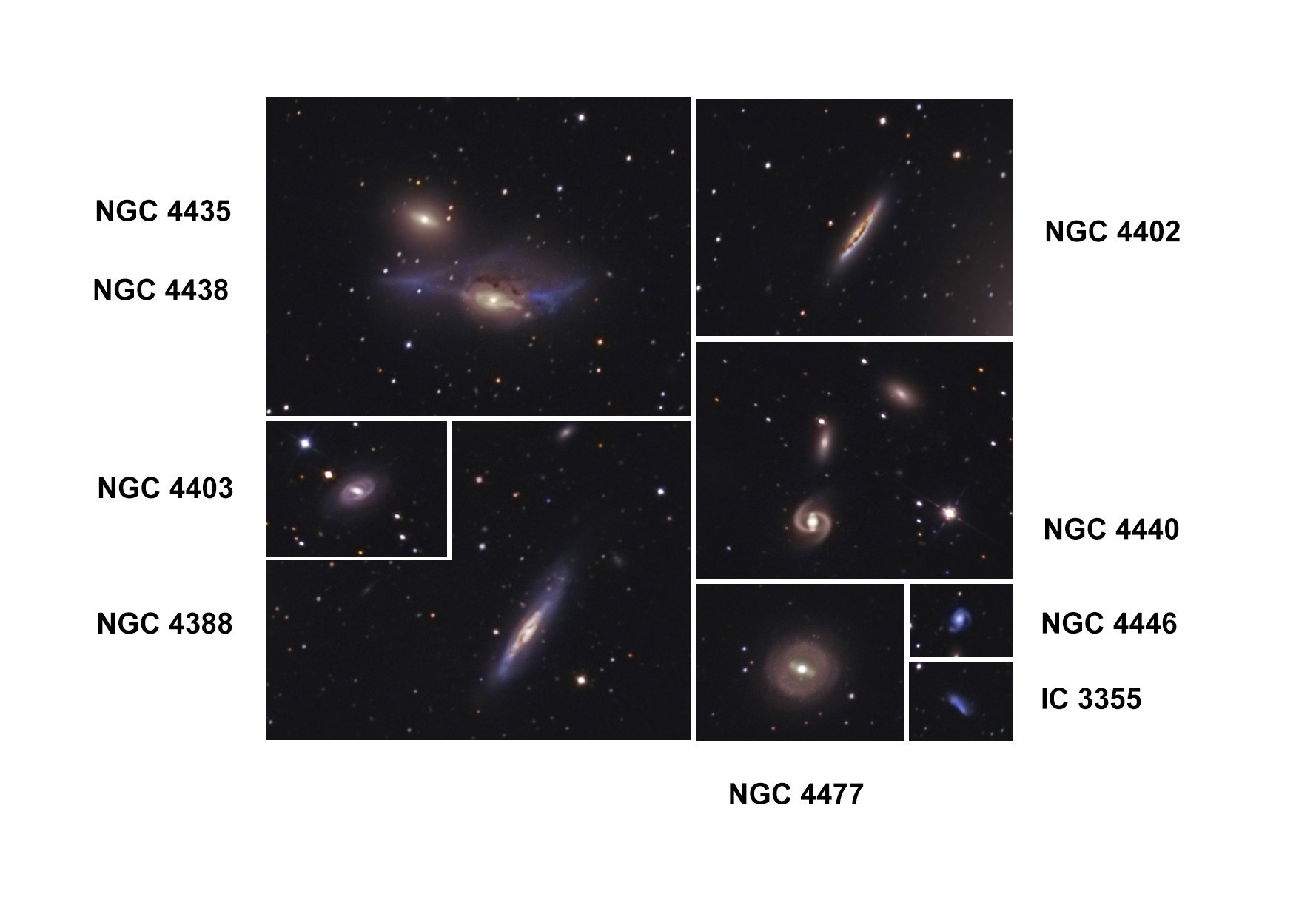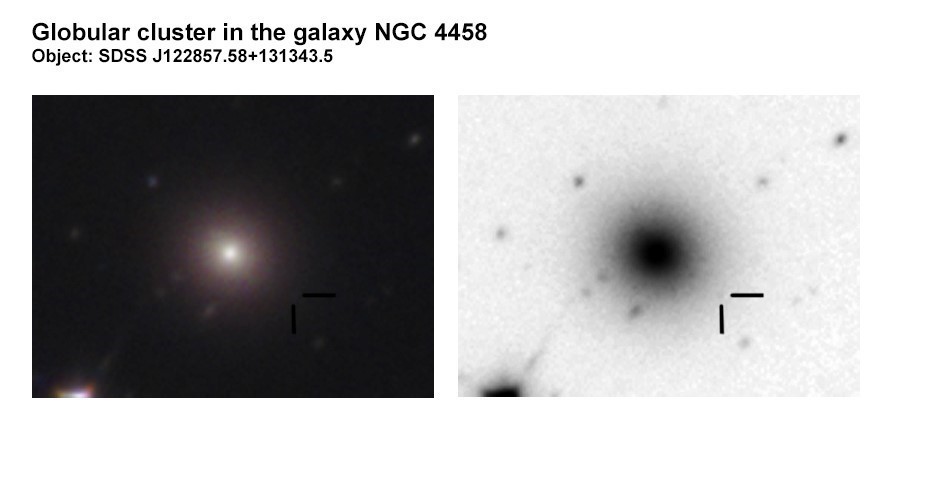25 March 2012
Astrograph 200/800 mm reducer/corrector 2" ASA 2KORRR 0.73x
LRGB 400:120:130:160 min (13+ hours total)
The spring sky at our latitude provides incredible views to the far ends of the universe. The picture presents distinct group of galaxies located approximately in the centre of the Virgo galaxy cluster, which is also the center of Local supercluster of galaxies. This cluster is one of the closest neighbors of the Local group of galaxies, which includes also the Milky Way. The center of this cluster is about 20 Mpc faraway, which is more than 65 million light-years [1]. This means that photons captured in this image left the galaxies around the time when asteroid collided with the Earth on the border of Cretaceous and Paleocene era and ended the dominance of dinosauruses.
The group of galaxies in the picture is among amateur astronomers known as Markarian's chain owing to the position of brightest galaxies in the image. Prominent objects in the image are mainly two elliptical galaxies Messier 84 (NGC 4374) and Messier 86 (NGC 4406) on the right side. Another significant object is pair of interacting galaxies NGC 4435 and NGC 4438 whose structure is affected by an collision with a large elliptical galaxy M86 about 100 milion years ago [2].

Image 1. Some notable galaxies of Markarian's chain. Click image for identification of galaxies in star field.
One of the curiosities in the image is globular cluster belonging to the faraway galaxy NGC 4458. In the image below, the cluster is barely visible point in the intersection of two indicative lines. However, when we take into consideration huge distance of the galaxy, the cluster must be realy giant, much bigger than famous Omega Centauri belonging to our Milky Way.

Image 2. Globular cluster in the galaxy NGC 4458
Many of the galaxies I captured on the sensor are fascinating, but the most interesting objects in the image are definitelly quasars (quasi-stellar objects). As the name suggests, it is the object with stellar appearence, but have nothing to do with stars. These objects lies in unimaginable vast depths of our universe, just on the borders we are able to observe. Quasars are also the brightest sources of radiation in outer space. The definition says that quasars are objects with large redshift in the spectrum, broad spectral lines and the small size relative to galaxies. It is assumed that quasars are part of the early stages of galaxies evolution. Quasars are found mostly in the center of the host galaxies and their luminosity exceeds several times luminosity of entire galaxy. For a long time, speculations about the source of energy that powers the quasars arose, due to the fact that fusion is not able to release such amount of energy. Based on current knowledges, it is assumed that in the center of the quasar is a supermassive black hole capable to release up to 60% of the potential energy from material falling to it. Quasars usually composed from three parts [3]:
Image bellow presents 17 quasars identified in my picture by means of Aladin Sky Atlas and NED database (NASA/IPAC EXTRAGALACTIC DATABASE) [4,5]. The most distant quasar, labeled SDSS J122602.10+132114.5 has red shift z= 3.532 and is located approximately 11.5 billions light-years far from Earth [4]. It is the most distant object captured by me, so far (2012). In the table below can be found some basic data about the quasars identified in the image.
Table 1. List of quasars identified in the picture. Quasars are sorted according to redshift "z"
| Catalog number | RA | DE | z | Magnitude | Distance GLy |
|---|---|---|---|---|---|
| 2MASX J12270987+1248542 | 12h 27m 09.8s | +12° 48' 55" | 0.194 | 18.7 | 2.296 |
| SDSS J122723.75+135245.5 | 12h 27m 23.7s | +13° 52' 46" | 0.349 | 19.3 | 3.737 |
| SDSS J122628.22+134913.6 | 12h 26m 28.2s | +13° 49' 14" | 0.350 | 20.7 | 3.740 |
| SDSS J122757.20+130232.8 | 12h 27m 57.2s | +13° 02' 33" | 0.659 | 19.2 | 5.894 |
| SDSS J122830.46+123617.8 | 12h 28m 30.5s | +12° 36' 18" | 0.734 | 18.9 | 6.308 |
| LBQS 1222+1310 | 12h 24m 48.1s | +12° 54' 13" | 1.062 | 18.1 | 7.761 |
| [HB89] 1222+131 NED02 | 12h 25m 11.9s | +12° 51' 54" | 1.255 | 18.4 | 8.405 |
| SDSS J122556.21+130656.2 | 12h 25m 56.2s | +13° 06' 56" | 1.350 | 19.3 | 8.682 |
| SDSS J122515.65+124441.0 | 12h 25m 15.6s | +12° 44' 41" | 1.664 | 19.2 | 9.435 |
| LBQS 1222+1334 | 12h 25m 28.4s | +13° 17' 25" | 1.794 | 17.7 | 9.692 |
| SDSS J122634.11+131048.9 | 12h 26m 34.1s | +13° 10' 49" | 1.814 | 19.5 | 9.727 |
| LBQS 1224+1349 | 12h 26m 35.6s | +13° 32' 52" | 1.838 | 18.2 | 9.771 |
| SDSS J122654.39+135029.0 | 12h 26m 54.4s | +13° 50' 29" | 2.008 | 19.1 | 10.057 |
| LBQS 1224+1244 | 12h 27m 13.2s | +12° 28' 04" | 2.160 | 18.2 | 10.281 |
| [HB89] 1226+130 | 12h 28m 58.0s | +12° 45' 28" | 2.502 | 20.5 | 10.702 |
| SDSS J122826.33+130106.2 | 12h 28m 26.3s | +13° 01' 06" | 3.230 | 19.8 | 11.333 |
| SDSS J122602.10+132114.5 | 12h 26m 02.1s | +13° 21' 15" | 3.532 | 19.2 | 11.525 |
[1] http://ned.ipac.caltech.edu/level5/ESSAYS/Binggeli/binggeli.html
[3] Kleczek J., Velka encyklopedie vesmiru, Academia, 2002
[4] http://ned.ipac.caltech.edu/
[5] http://aladin.u-strasbg.fr/
***
Milos Hroch